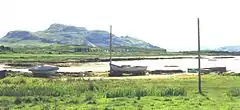Kilchoan
Kilchoan (Scottish Gaelic: Cille Chòmhain)[1] is a village on the Scottish peninsula of Ardnamurchan, in Lochaber, Highland. It is the most westerly village in Great Britain,[2] although several tiny hamlets lie further west on the peninsula (of these, the most westerly is called Portuairk). The western linear, coastal parts of the village are Ormsaigmore and Ormsaigbeg.
Kilchoan
| |
|---|---|
 Kilchoan Bay. Ben Hiant, the highest point of the peninsula rises beyond the small moored boats and bay. | |
 Kilchoan Location within the Lochaber area | |
| Population | 150 |
| OS grid reference | NM488637 |
| Council area | |
| Country | Scotland |
| Sovereign state | United Kingdom |
| Post town | Acharacle |
| Postcode district | PH36 4 |
| Police | Scotland |
| Fire | Scottish |
| Ambulance | Scottish |
| Scottish Parliament |
|
Kilchoan has a population of about 150 people altogether.[3]
History
Donaldson equates 'Buarblaig' (now Bourblaige about 3 miles east of Kilchoan on the other side of the eastern mountain of Ben Hiant at 528m, grid reference NM546623[4]) with Muribulg, where the Annals of Tigernach record a battle between the Picts and Dalriads in AD 731.[5] It may also be the 'Muirbole Paradisi' mentioned by Adomnán.[4]
Landmarks
The ancient Mingary Castle is on the coast about 1 km east of the village.
Examples of a type of igneous rock structure called a cone sheet are found at Kilchoan.
Below the slope north-west of the village street is a chambered cairn, Greadal Fhinn.[4]
Ben Hiant is the highest point of the peninsula at 528 m and lies between the village and the coastal hamlet of Ardslignish.
Tourism and amenities
Transport
A regular CalMac ferry service runs from Kilchoan to Tobermory on the Isle of Mull. To and from the regional centre of Fort William, one bus per day Monday to Saturday connects with the ferry via Salen and the Corran Ferry[n 1]
| Preceding station | Ferry | Following station | ||
|---|---|---|---|---|
| Terminus | Caledonian MacBrayne Ferry |
Tobermory |
Kilchoan Bay
Kilchoan Bay has four visitor moorings, a ferry jetty, a shop with a post office,[n 2] showers and a petrol station.
Hospitality
The Kilchoan House Hotel is now the most westerly bar/hotel on the mainland of the UK, after the closure of Sonachan Hotel.
Ardnamurchan Campsite, Kilchoan.[n 3]
Geology
The minerals kilchoanite, dellaite and rustumite were first found at Kilchoan. A natural history museum is adjacent to the hamlet to the east at the coastal hamlet of Glenmore.[6]
Notes and references
- References
- "Ainmean-Àite na h-Alba - Gaelic Place-Names of Scotland - Database Kilchoan". www.gaelicplacenames.org. Retrieved 15 May 2017.
- "Kilchoan". Undiscovered Scotland. Retrieved 5 April 2011.
- Scottish Neighbourhood Statistics: Data Zone S01003739 Kilchoan forms an imprecise division no more than 5% of the land and has no more than a third of the population of this area, 541 people.
- "Site Record for Ardnamurchan, Bourblaige". Royal Commission on the Ancient and Historical Monuments of Scotland.
- Donaldson, M.E.M. (1923). Wanderings in the Western Highlands and Islands: Recounting Highland & Clan History, Traditions, Ecclesiology, Archaeology, Romance, Literature, Humour, Folk-Lore, Etc (2nd rev. ed.). Paisley: A. Gardner. OCLC 858596051.
- Livingstone, Alec (2002). Minerals of Scotland. Edinburgh: National Museums of Scotland. ISBN 1901663469.
- Notes
- The route is 50 km long, and passes beside Loch Sunart, Glen Tarbert and Loch Linnhe
- This shop was once run by author Jon Haylett
- About 500m west of the centre
External links
![]() Media related to Kilchoan at Wikimedia Commons
Media related to Kilchoan at Wikimedia Commons